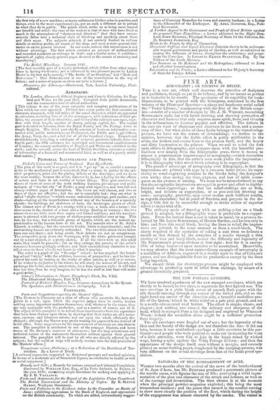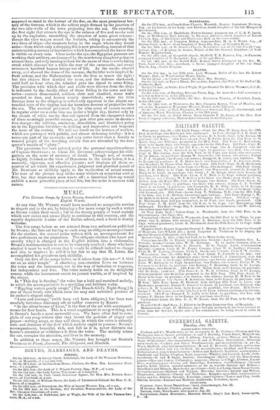PANORAMA OF THE BOMBARDMENT OF ACRE.
WrEarst two months after the arrival of the news of the bombardment of St. Jean d'Acre, has Mr. BURFORD produced a panoramic picture of the terrific scene, with figures the size of life ; conveying a vivid repre- sentation of the plan and character of the attack and defence, as well as of the carnage and devastation. The time chosen is at the moment when the principal powder-magazine exploded ; this being the most tremendous incident; and the pause that ensued in the conflict serving to show more clearly the position of the fleet, which during the height of the engagement was almost obscured by the smoke. The visitor is
supposed to stand in the hottest of the fire, on the most prominent bat- tery of the fortress, which is the salient angle formed by the junction of the two side-walls of the town projecting into the sea. On entering, the first sight that attracts the eye is the column of fire and smoke sent up by the explosion, resembling the eruption of some great volcano : thence the view ranges round the horizon, taking in successively the two lines of ships—the steamers being in the angle where they would smite—from which only a dropping fire is now proceeding, instead of that smintermitting torrent of destruction which has committed the havoc that is visible on every side. Close under the eye, the Egyptian gunners are working their artillery, undismayed by the murderous slaughter going on around them, and only turning to look for the cause of that overwhelming crash which silenced for a while the roar of the cannonade, and swept seventeen hundred human beings out of life. As the smoke cleared away, and showed the dome of the mosque, the faithful were inspired by- fresh
ardour, and the Mahomedans were the first to renew the fight ; but this chance blow decided the issue, and the defence slackened, until half an hour after, the Admiral gave the signal to cease firing. The precision with which shot and shells were thrown from the ships is indicated by the deadly effect of those falling in the town and bat- teries—cannon dismounted, soldiers slain and disabled, stone walls pounded to dust, and houses utterly demolished ; while the little damage done to the shipping is sufficiently apparent in the almost un- touched state of the rigging and the harmless descent of projectiles into the sea. The contrast presented by the trim array of vessels moored in regular order on a calm blue sea under a bright sky, blotted only by the clouds of white smoke that roll upward from the chequered sides of these seemingly peaceful masses, as gun after gun emits its destruc- tive charge—the activity, confusion, demolition, and bloodshed going on in the Egyptian batteries—is striking and impressive, and bespeaks the issue of the contest. We will not dwell on the horrors of warfare, which are portrayed with painful, and almost sickening fidelity : it is a necessary part of the spectacle, and may serve better than a homily to remind people of the revolting details that are shrouded by the con- queror's mantle of " glory." The panorama has been painted under the personal superintendence of Captain STOPFOnD ; to whom Mr. BURFORD acknowledges his obli- gations on the score of accuracy of detail. Though not, of course, so highly finished as the view of Damascus in the circle below, it is a masterly, vigorous, and effective picture ; and displays all those re- sources of art which the experienced judgment and practical pencil of Mr. BURFORD so skilfully apply to the realization of actual scenes. The tone of the picture may strike some visiters as somewhat cold at first, but that impression soon wears off: a theatrical blow-up would exhibit a more powerful glare of red fire, but the artist is content with nature.



























 Previous page
Previous page